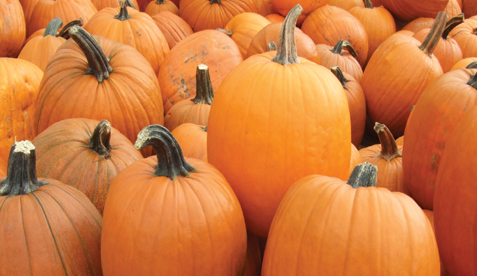Pumpkins are autumn. And these bright orange globes from the garden not only usher in the colorful fall season but they serve as beacons to the approaching mischief that is Halloween. However, pumpkins, while certainly being the perfect decoration for this time of year, are edible as well.
With Thanksgiving following closely on the heels of Halloween, it makes sense to repurpose a perfectly good pumpkin from being a decoration to becoming the prime component of such holiday treats as pumpkin bread, pumpkin muffins and, of course, pumpkin pie. In addition, pumpkin pulp is often used as a “secret ingredient” in many holiday turkey or vegetable stuffings.
Being able to save your pumpkin after fall and Halloween festivities for culinary use depends, first and foremost, on the condition of the Big Orange itself. In order for it to store properly, a pumpkin must be relatively unblemished. This means no knife cuts and no soft spots. The outer shell must be hard and intact to prevent rot-producing organisms from getting inside and spoiling the edible pulp.
In addition, make sure there is a bit of stem left on the pumpkin, as it will last much longer in storage with 2 to 3 inches of stem still attached.
In short, if you carved your pumpkin, if you dropped it several times getting it out of the car or if you picked a stemless pumpkin, it won’t do for storage purposes.
If you were smart enough to grow pumpkins in your garden this year, they can certainly be saved as well. The trick to properly harvesting pumpkins for storage is timing. Wait until a pumpkin is fully ripe before cutting it from the vine.
How do you know when a pumpkin is ready for picking? Give it two tests. First, check the stem — if it is hard, the pumpkin is ready to go. Second, thump the pumpkin. Hear a hollow sound? Great! It’s harvest time!
Also, you’ve heard the phrase, “The frost is on the pumpkin”? If you are going to be storing any, don’t let it happen to your picks, as the ice crystals can damage the pumpkins’ skin.
In order for a pumpkin to store properly, its outer skin needs to be toughened up. This is easily done by leaving it in an area of moderate temperature (about 80 degrees) for about two weeks. If the pumpkin is used as a Halloween decoration and is in a dry area that is not in direct sunlight, it is well on its way to being cured for sure.
Basic Pumpkin-ology 101: One thing to remember about a picked pumpkin is that, even though it has been cut from a vine, it is still alive. In continues to respire (people breathe, wheeze and pant; fruits and vegetables respire) and thus mature. If its respiration rate is slowed down, the day your pumpkin turns into a pile of mush is pushed back.
Putting a pumpkin in a cool place after it has been cured will slow down its respiration rate. In fact, this rate will be cut in half for every 18-degree drop in temperature. Below 50 degrees though, some cold damage could occur, so the refrigerator is out of the question. Besides, who in the world has that much room in the ol’ icebox for a great big pumpkin?
Basements are ideal for pumpkin storage because they are constantly cool and, as an added bonus, usually a little on the humid side. Humidity, in moderate amounts, helps to reduce shrinkage. As with low temperatures, too much humidity (more than 85 percent)
can harm the pumpkin because it could cause condensation to form on the rind, providing an ideal environment that encourages disease development. If you don’t have a basement, a garage, tool shed or closet could also work.
Don’t place your pumpkin directly on a concrete floor, as the chilly cement could damage the rind. In fact, don’t put a pumpkin on a floor, period. This is where humidity is the highest and air circulation is usually the lowest. Tuck your pumpkin away on a shelf, possibly in a bed of straw or shredded newspaper to help keep the pumpkin dry.
If you are storing other fruits and vegetables as well, keep the pumpkin away from pears, apples and other ripening fruit, as they emit ethylene gas, which shortens the pumpkin’s storage life.
Before putting your pumpkin away, wipe off any dirt with a dry cloth. Avoid using a wet cloth because it moistens the outer skin and invites a bacterial attack.
After you tuck your Great Pumpkin away, don’t forget about it! Check in on it occasionally and, if any mold appears, wipe it off with a cloth that has a little vegetable oil on it. A minor case of mold on the skin won’t harm the inside of the pumpkin — just don’t let it get out of hand. Mold can not only spread over the outer rind but it can also penetrate into the pumpkin, if not checked.
A properly stored pumpkin can usually last two to three months. This means that, if someone else is already bringing pumpkin pie to Thanksgiving dinner, you can return the favor at Christmas!
L.A. Jackson is the former editor of Carolina Gardener magazine. If you would like to ask him a question about your garden, go to his website at www.southeastgardening.com






